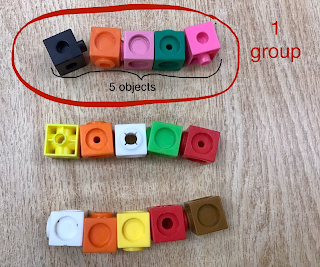Math Strategy: Counting Rhythmically
Math strand: Multiplication - Number Sense and Numeration
English Video:
French Video:
Overview:
Counting rhythmically occurs when students have moved beyond counting by one. During this strategy students often still rely on directly modelling the problem (showing it with manipulatives or drawing pictures to represent the problem they are solving). They then use this model to count the total, emphasizing the last number in each set as they count.
For example, if the student is asked to solve a problem where they need to find the product of 3 x 5, you might see the student make 3 groups of 5 and then hear them count: “1, 2, 3, 4, 5…6, 7, 8, 9, 10…11, 12, 13, 14, 15”.
How this supports student learning:
Students need the opportunity to experience multiplication through hands-on experiences first. In order to build an understanding, they need the chance to physically make equal groups with manipulatives and to count them. Providing these hands-on experiences helps students build proficiency with unitizing, which is the idea that objects can be seen as one group at the same time as they are seen as a group of objects that can be each counted individually. This concept is foundational for moving to a more abstract understanding of multiplication.
Where to next
Counting rhythmically is a natural progression to skip
counting. At the beginning students may
require the model in order to properly track the number of groups being
counted, however as they become more proficient, they will be able to do this
mentally. To help develop a students
understanding of unitizing, take a look on page 185-186 of “What to Look
For” by Alex Lawson. In the same
book, have a look on page 187 and 196 in for activities that support
skip-counting. The activities mentioned
above are also available in French in the digital version of the book which
teachers have access to when the paper copy is purchased.
Guide
to Effective Mathematics Instruction Number Sense and Numeration, Grades 1 to 3
(revised 2017) page 143 "Trading Up to 1000" and page 149
"What Comes in 2’s, 3’s, and 4’s?".



No comments:
Post a Comment